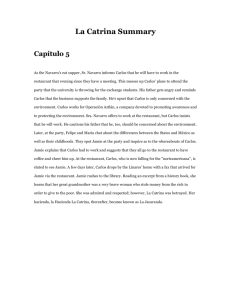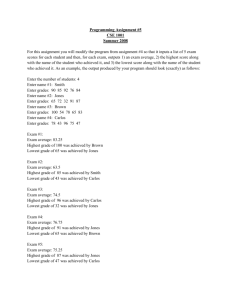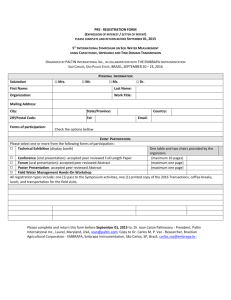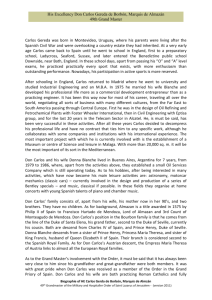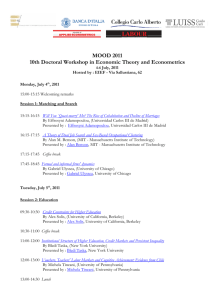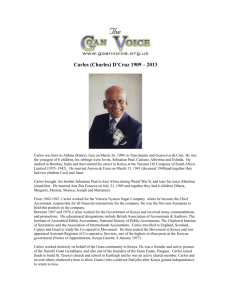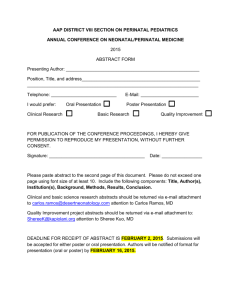Principal Components Analysis in Yield
advertisement
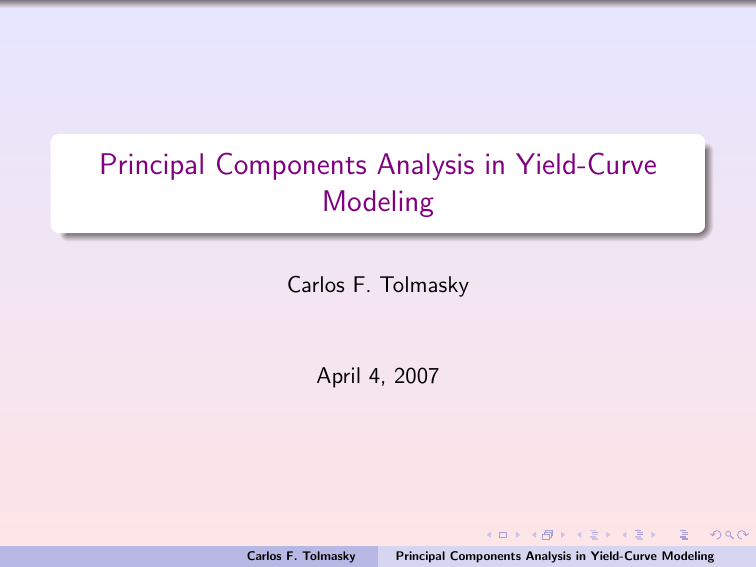
Principal Components Analysis in Yield-Curve Modeling Carlos F. Tolmasky April 4, 2007 Carlos F. Tolmasky Principal Components Analysis in Yield-Curve Modeling Term Structure Models Black-Scholes models 1 underlying. Carlos F. Tolmasky Principal Components Analysis in Yield-Curve Modeling Term Structure Models Black-Scholes models 1 underlying. What if we need more? spread, basket options. Carlos F. Tolmasky Principal Components Analysis in Yield-Curve Modeling Term Structure Models Black-Scholes models 1 underlying. What if we need more? spread, basket options. Need correlation structure of the market. Carlos F. Tolmasky Principal Components Analysis in Yield-Curve Modeling Term Structure Models Black-Scholes models 1 underlying. What if we need more? spread, basket options. Need correlation structure of the market. What if the market is naturally a curve? Carlos F. Tolmasky Principal Components Analysis in Yield-Curve Modeling Term Structure Models Black-Scholes models 1 underlying. What if we need more? spread, basket options. Need correlation structure of the market. What if the market is naturally a curve? Interest rates. Carlos F. Tolmasky Principal Components Analysis in Yield-Curve Modeling Term Structure Models Black-Scholes models 1 underlying. What if we need more? spread, basket options. Need correlation structure of the market. What if the market is naturally a curve? Interest rates. Commodities. Carlos F. Tolmasky Principal Components Analysis in Yield-Curve Modeling Term Structure Models Black-Scholes models 1 underlying. What if we need more? spread, basket options. Need correlation structure of the market. What if the market is naturally a curve? Interest rates. Commodities. Does it make sense to model each underlying individually? Carlos F. Tolmasky Principal Components Analysis in Yield-Curve Modeling Front Month Crude Carlos F. Tolmasky Principal Components Analysis in Yield-Curve Modeling Crude Curve Carlos F. Tolmasky Principal Components Analysis in Yield-Curve Modeling Yield Curve Carlos F. Tolmasky Principal Components Analysis in Yield-Curve Modeling Japanese Yield Curve Carlos F. Tolmasky Principal Components Analysis in Yield-Curve Modeling Crude Curve through time Carlos F. Tolmasky Principal Components Analysis in Yield-Curve Modeling Natural Gas Curve through time Carlos F. Tolmasky Principal Components Analysis in Yield-Curve Modeling Term Structure Models Historically, different approaches: Carlos F. Tolmasky Principal Components Analysis in Yield-Curve Modeling Term Structure Models Historically, different approaches: Black’s model: Each possible underlying is lognormal. Carlos F. Tolmasky Principal Components Analysis in Yield-Curve Modeling Term Structure Models Historically, different approaches: Black’s model: Each possible underlying is lognormal. What if we need to use more than one rate? Carlos F. Tolmasky Principal Components Analysis in Yield-Curve Modeling Term Structure Models Historically, different approaches: Black’s model: Each possible underlying is lognormal. What if we need to use more than one rate? 1-Factor models (Vasicek, Ho-Lee) Model the short rate, derive the rest of the curve from it. Carlos F. Tolmasky Principal Components Analysis in Yield-Curve Modeling Term Structure Models Historically, different approaches: Black’s model: Each possible underlying is lognormal. What if we need to use more than one rate? 1-Factor models (Vasicek, Ho-Lee) Model the short rate, derive the rest of the curve from it. 1-factor not rich enough, how do we add factors? Carlos F. Tolmasky Principal Components Analysis in Yield-Curve Modeling Term Structure Models Historically, different approaches: Black’s model: Each possible underlying is lognormal. What if we need to use more than one rate? 1-Factor models (Vasicek, Ho-Lee) Model the short rate, derive the rest of the curve from it. 1-factor not rich enough, how do we add factors? Adding factors not obvious. Carlos F. Tolmasky Principal Components Analysis in Yield-Curve Modeling Term Structure Models Historically, different approaches: Black’s model: Each possible underlying is lognormal. What if we need to use more than one rate? 1-Factor models (Vasicek, Ho-Lee) Model the short rate, derive the rest of the curve from it. 1-factor not rich enough, how do we add factors? Adding factors not obvious. HJM Forget Black-Scholes.. Carlos F. Tolmasky Principal Components Analysis in Yield-Curve Modeling Term Structure Models Historically, different approaches: Black’s model: Each possible underlying is lognormal. What if we need to use more than one rate? 1-Factor models (Vasicek, Ho-Lee) Model the short rate, derive the rest of the curve from it. 1-factor not rich enough, how do we add factors? Adding factors not obvious. HJM Forget Black-Scholes.. Model the whole curve. Carlos F. Tolmasky Principal Components Analysis in Yield-Curve Modeling HJM How?? ∞-many points. Carlos F. Tolmasky Principal Components Analysis in Yield-Curve Modeling HJM How?? ∞-many points. However correlation is high. Carlos F. Tolmasky Principal Components Analysis in Yield-Curve Modeling HJM How?? ∞-many points. However correlation is high. Maybe the moves ”live” in a lower dimensional space. Carlos F. Tolmasky Principal Components Analysis in Yield-Curve Modeling HJM How?? ∞-many points. However correlation is high. Maybe the moves ”live” in a lower dimensional space. Instead of dFi = σi dWi Fi i = 1, ..., n with Wi , Wj correlated do Carlos F. Tolmasky Principal Components Analysis in Yield-Curve Modeling HJM How?? ∞-many points. However correlation is high. Maybe the moves ”live” in a lower dimensional space. Instead of dFi = σi dWi Fi i = 1, ..., n with Wi , Wj correlated do k X dFi = σj,i dWj Fi k < n (hopefully) i=1 Carlos F. Tolmasky Principal Components Analysis in Yield-Curve Modeling HJM How?? ∞-many points. However correlation is high. Maybe the moves ”live” in a lower dimensional space. Instead of dFi = σi dWi Fi i = 1, ..., n with Wi , Wj correlated do k X dFi = σj,i dWj Fi k < n (hopefully) i=1 But, how do we choose the σj,i ?? Carlos F. Tolmasky Principal Components Analysis in Yield-Curve Modeling PCA Technique to reduce dimensionality. Carlos F. Tolmasky Principal Components Analysis in Yield-Curve Modeling PCA Technique to reduce dimensionality. If X is the matrix containing our data, we look for w so that arg maxkw k=1 Var(w T X ) Carlos F. Tolmasky Principal Components Analysis in Yield-Curve Modeling PCA Technique to reduce dimensionality. If X is the matrix containing our data, we look for w so that arg maxkw k=1 Var(w T X ) Then we do the same in the subspace orthogonal to w . Carlos F. Tolmasky Principal Components Analysis in Yield-Curve Modeling PCA Technique to reduce dimensionality. If X is the matrix containing our data, we look for w so that arg maxkw k=1 Var(w T X ) Then we do the same in the subspace orthogonal to w . It is equivalent to diagonalizing the covariance matrix. Carlos F. Tolmasky Principal Components Analysis in Yield-Curve Modeling PCA Technique to reduce dimensionality. If X is the matrix containing our data, we look for w so that arg maxkw k=1 Var(w T X ) Then we do the same in the subspace orthogonal to w . It is equivalent to diagonalizing the covariance matrix. Carlos F. Tolmasky Principal Components Analysis in Yield-Curve Modeling Litterman-Scheikman (1991) Looked at the treasury yield curve. Carlos F. Tolmasky Principal Components Analysis in Yield-Curve Modeling Litterman-Scheikman (1991) Looked at the treasury yield curve. Found that just a few eigenvectors are the important ones. Carlos F. Tolmasky Principal Components Analysis in Yield-Curve Modeling Litterman-Scheikman (1991) Looked at the treasury yield curve. Found that just a few eigenvectors are the important ones. Three of them explain most of the moves. Carlos F. Tolmasky Principal Components Analysis in Yield-Curve Modeling Litterman-Scheikman (1991) Looked at the treasury yield curve. Found that just a few eigenvectors are the important ones. Three of them explain most of the moves. Level-Slope-Curvature Carlos F. Tolmasky Principal Components Analysis in Yield-Curve Modeling Litterman-Scheikman (1991) Looked at the treasury yield curve. Found that just a few eigenvectors are the important ones. Three of them explain most of the moves. Level-Slope-Curvature Very Intuitive. Carlos F. Tolmasky Principal Components Analysis in Yield-Curve Modeling Litterman-Scheikman (1991) Looked at the treasury yield curve. Found that just a few eigenvectors are the important ones. Three of them explain most of the moves. Level-Slope-Curvature Very Intuitive. Curve trades. Carlos F. Tolmasky Principal Components Analysis in Yield-Curve Modeling Litterman-Scheikman (1991) Looked at the treasury yield curve. Found that just a few eigenvectors are the important ones. Three of them explain most of the moves. Level-Slope-Curvature Very Intuitive. Curve trades. Cortazar-Schwartz (2004) found the same in copper Carlos F. Tolmasky Principal Components Analysis in Yield-Curve Modeling Litterman-Scheikman (1991) Looked at the treasury yield curve. Found that just a few eigenvectors are the important ones. Three of them explain most of the moves. Level-Slope-Curvature Very Intuitive. Curve trades. Cortazar-Schwartz (2004) found the same in copper Loads (or lots?) of other people report the same kind of results in many other markets. Carlos F. Tolmasky Principal Components Analysis in Yield-Curve Modeling Predictive Power Recently, some work has been done on this. Carlos F. Tolmasky Principal Components Analysis in Yield-Curve Modeling Predictive Power Recently, some work has been done on this. Mönch (2006) Studies innovations in level-slope-curvature wrt macro variables. Carlos F. Tolmasky Principal Components Analysis in Yield-Curve Modeling Predictive Power Recently, some work has been done on this. Mönch (2006) Studies innovations in level-slope-curvature wrt macro variables. Positive answer for curvature. Carlos F. Tolmasky Principal Components Analysis in Yield-Curve Modeling Predictive Power Recently, some work has been done on this. Mönch (2006) Studies innovations in level-slope-curvature wrt macro variables. Positive answer for curvature. Diebold-Li (2006) Use autoregressive models for each component. Carlos F. Tolmasky Principal Components Analysis in Yield-Curve Modeling Predictive Power Recently, some work has been done on this. Mönch (2006) Studies innovations in level-slope-curvature wrt macro variables. Positive answer for curvature. Diebold-Li (2006) Use autoregressive models for each component. Study forecast power at short and long horizons. Carlos F. Tolmasky Principal Components Analysis in Yield-Curve Modeling Predictive Power Recently, some work has been done on this. Mönch (2006) Studies innovations in level-slope-curvature wrt macro variables. Positive answer for curvature. Diebold-Li (2006) Use autoregressive models for each component. Study forecast power at short and long horizons. Report encouraging results at long horizons. Carlos F. Tolmasky Principal Components Analysis in Yield-Curve Modeling Predictive Power Recently, some work has been done on this. Mönch (2006) Studies innovations in level-slope-curvature wrt macro variables. Positive answer for curvature. Diebold-Li (2006) Use autoregressive models for each component. Study forecast power at short and long horizons. Report encouraging results at long horizons. Chantziara-Skiadopoulos (2005). Study predictive power in oil. Carlos F. Tolmasky Principal Components Analysis in Yield-Curve Modeling Predictive Power Recently, some work has been done on this. Mönch (2006) Studies innovations in level-slope-curvature wrt macro variables. Positive answer for curvature. Diebold-Li (2006) Use autoregressive models for each component. Study forecast power at short and long horizons. Report encouraging results at long horizons. Chantziara-Skiadopoulos (2005). Study predictive power in oil. Results are weak. Carlos F. Tolmasky Principal Components Analysis in Yield-Curve Modeling Predictive Power Recently, some work has been done on this. Mönch (2006) Studies innovations in level-slope-curvature wrt macro variables. Positive answer for curvature. Diebold-Li (2006) Use autoregressive models for each component. Study forecast power at short and long horizons. Report encouraging results at long horizons. Chantziara-Skiadopoulos (2005). Study predictive power in oil. Results are weak. Also look at spillover effects among crude (WTI and IPE), heating oil and gasoline. Carlos F. Tolmasky Principal Components Analysis in Yield-Curve Modeling Predictive Power Recently, some work has been done on this. Mönch (2006) Studies innovations in level-slope-curvature wrt macro variables. Positive answer for curvature. Diebold-Li (2006) Use autoregressive models for each component. Study forecast power at short and long horizons. Report encouraging results at long horizons. Chantziara-Skiadopoulos (2005). Study predictive power in oil. Results are weak. Also look at spillover effects among crude (WTI and IPE), heating oil and gasoline. Some spillover effects found. Carlos F. Tolmasky Principal Components Analysis in Yield-Curve Modeling Table: Correlation Matrix for Changes of the First 12 Crude Oil Futures Prices 1.000 0.992 0.980 0.966 0.951 0.936 0.922 0.08 0.892 0.877 0.860 0.848 0.992 1.000 0.996 0.988 0.978 0.966 0.954 0.941 0.927 0.913 0.898 0.886 0.980 0.996 1.000 0.997 0.991 0.982 0.973 0.963 0.951 0.939 0.925 0.914 0.966 0.988 0.997 1.000 0.998 0.993 0.986 0.978 0.968 0.958 0.946 0.936 0.951 0.978 0.991 0.998 1.000 0.998 0.994 0.989 0.981 0.972 0.963 0.954 0.936 0.966 0.982 0.993 0.998 1.000 0.999 0.995 0.90 0.983 0.975 0.967 Carlos F. Tolmasky 0.922 0.954 0.973 0.986 0.994 0.999 1.000 0.999 0.996 0.991 0.984 0.978 0.08 0.941 0.963 0.978 0.989 0.995 0.999 1.000 0.999 0.996 0.991 0.985 0.892 0.927 0.951 0.968 0.981 0.90 0.996 0.999 1.000 0.999 0.995 0.991 0.877 0.913 0.939 0.958 0.972 0.983 0.991 0.996 0.999 1.000 0.998 0.996 0.860 0.898 0.925 0.946 0.963 0.975 0.984 0.991 0.995 0.998 1.000 0.998 0.848 0.886 0.914 0.936 0.954 0.967 0.978 0.985 0.991 0.996 0.998 1.000 Principal Components Analysis in Yield-Curve Modeling −0.6 −0.4 −0.2 0.0 0.2 0.4 0.6 First four eigenvectors for oil 2 4 6 8 10 12 Contract Carlos F. Tolmasky Principal Components Analysis in Yield-Curve Modeling −0.6 −0.4 −0.2 0.0 0.2 0.4 0.6 First four eigenvectors for oil 2 4 6 8 10 12 Contract Carlos F. Tolmasky Principal Components Analysis in Yield-Curve Modeling −0.6 −0.4 −0.2 0.0 0.2 0.4 0.6 First four eigenvectors for oil 2 4 6 8 10 12 Contract Carlos F. Tolmasky Principal Components Analysis in Yield-Curve Modeling −0.6 −0.4 −0.2 0.0 0.2 0.4 0.6 First four eigenvectors for oil 2 4 6 8 10 12 Contract Carlos F. Tolmasky Principal Components Analysis in Yield-Curve Modeling Forzani-T (2003) Why is the result ”market-invariant”? Carlos F. Tolmasky Principal Components Analysis in Yield-Curve Modeling Forzani-T (2003) Why is the result ”market-invariant”? Because all the correlation matrices are very similar. Carlos F. Tolmasky Principal Components Analysis in Yield-Curve Modeling Forzani-T (2003) Why is the result ”market-invariant”? Because all the correlation matrices are very similar. They all look like ρ|i−j| with ρ close to 1. Carlos F. Tolmasky Principal Components Analysis in Yield-Curve Modeling Forzani-T (2003) Why is the result ”market-invariant”? Because all the correlation matrices are very similar. They all look like ρ|i−j| with ρ close to 1. Proved that the eigenvectors of those matrices converge to cos(nx) when ρ → 1 . Carlos F. Tolmasky Principal Components Analysis in Yield-Curve Modeling Forzani-T (2003) Correlation matrix: T 1 ρn T ρn 1 ... ... ... ... (n−1) Tn (n−2) Tn ρ ρ T n Tn ρ(n−1) n ρ T ρ2 n T ρn ... ... T ρ(n−3) n T ρ(n−2) n ... ... ... ... ... ... ... ... ... 1 T ... ρ n T ρn n T ρ(n−1) n ... ... ρ Tn 1 or, as an operator: Z Kρ f (x) = T ρ|y −x| f (y )dy . (1) 0 Carlos F. Tolmasky Principal Components Analysis in Yield-Curve Modeling Lekkos (2000) A big part of the correlation structure is given by: R(t, T1 )T1 = R(t, T0 )T0 + f (t, T0 , T1 )(T1 − T0 ) Carlos F. Tolmasky Principal Components Analysis in Yield-Curve Modeling Lekkos (2000) A big part of the correlation structure is given by: R(t, T1 )T1 = R(t, T0 )T0 + f (t, T0 , T1 )(T1 − T0 ) So, it is an artifact. Carlos F. Tolmasky Principal Components Analysis in Yield-Curve Modeling Lekkos (2000) A big part of the correlation structure is given by: R(t, T1 )T1 = R(t, T0 )T0 + f (t, T0 , T1 )(T1 − T0 ) So, it is an artifact. Even if we generate independent forwards we find structure in the correlation matrix of the zeros. Carlos F. Tolmasky Principal Components Analysis in Yield-Curve Modeling Lekkos (2000) A big part of the correlation structure is given by: R(t, T1 )T1 = R(t, T0 )T0 + f (t, T0 , T1 )(T1 − T0 ) So, it is an artifact. Even if we generate independent forwards we find structure in the correlation matrix of the zeros. Looked at the PCAs of fwds in various markets, found nothing interesting. Carlos F. Tolmasky Principal Components Analysis in Yield-Curve Modeling Alexander-Lvov (2003) They study different fitting techniques for the yield curve. Carlos F. Tolmasky Principal Components Analysis in Yield-Curve Modeling Alexander-Lvov (2003) They study different fitting techniques for the yield curve. Found that this choice is crucial to the correlation structure obtained. Carlos F. Tolmasky Principal Components Analysis in Yield-Curve Modeling Alexander-Lvov (2003) They study different fitting techniques for the yield curve. Found that this choice is crucial to the correlation structure obtained. Could Lekkos’ critique be just a matter of the choice of the fitting technique? Carlos F. Tolmasky Principal Components Analysis in Yield-Curve Modeling Lord, Pessler (2005) They ask the question: Carlos F. Tolmasky Principal Components Analysis in Yield-Curve Modeling Lord, Pessler (2005) They ask the question: Can we characterize ”level-slope-curvature”? Carlos F. Tolmasky Principal Components Analysis in Yield-Curve Modeling Lord, Pessler (2005) They ask the question: Can we characterize ”level-slope-curvature”? They look at sign changes in the eigenvectors. Carlos F. Tolmasky Principal Components Analysis in Yield-Curve Modeling Lord, Pessler (2005) They ask the question: Can we characterize ”level-slope-curvature”? They look at sign changes in the eigenvectors. ”Level” means no sign changes. Carlos F. Tolmasky Principal Components Analysis in Yield-Curve Modeling Lord, Pessler (2005) They ask the question: Can we characterize ”level-slope-curvature”? They look at sign changes in the eigenvectors. ”Level” means no sign changes. This is solved by Perron’s theorem. Carlos F. Tolmasky Principal Components Analysis in Yield-Curve Modeling Lord, Pessler (2005) Perron’s Theorem: Let A be an N × N matrix, all of whose elements are strictly positive. Then A has a positive eigenvalue of algebraic multiplicity equal to 1, which is strictly greater in modulus than all other eigenvalues of A. Furthermore, the unique (up to multiplication by a non-zero constant) associated eigenvector may be chosen so that all its components are strictly positive. Carlos F. Tolmasky Principal Components Analysis in Yield-Curve Modeling Lord-Pessler (2005) A square matrix A is said to be totally positive (TP) when for all p-uples n, m and p ≤ N, the matrix formed by the elements ani ,mj has nonnegative determinant. Carlos F. Tolmasky Principal Components Analysis in Yield-Curve Modeling Lord-Pessler (2005) A square matrix A is said to be totally positive (TP) when for all p-uples n, m and p ≤ N, the matrix formed by the elements ani ,mj has nonnegative determinant. If that condition is valid only for p ≤ k < N then A is called TPk . Carlos F. Tolmasky Principal Components Analysis in Yield-Curve Modeling Lord-Pessler (2005) A square matrix A is said to be totally positive (TP) when for all p-uples n, m and p ≤ N, the matrix formed by the elements ani ,mj has nonnegative determinant. If that condition is valid only for p ≤ k < N then A is called TPk . If those dets are strictly positive they are called strictly totally positive (STP). Carlos F. Tolmasky Principal Components Analysis in Yield-Curve Modeling Lord-Pessler (2005) A square matrix A is said to be totally positive (TP) when for all p-uples n, m and p ≤ N, the matrix formed by the elements ani ,mj has nonnegative determinant. If that condition is valid only for p ≤ k < N then A is called TPk . If those dets are strictly positive they are called strictly totally positive (STP). This is all classical stuff in matrix theory. Carlos F. Tolmasky Principal Components Analysis in Yield-Curve Modeling Lord-Pessler (2005) A square matrix A is said to be totally positive (TP) when for all p-uples n, m and p ≤ N, the matrix formed by the elements ani ,mj has nonnegative determinant. If that condition is valid only for p ≤ k < N then A is called TPk . If those dets are strictly positive they are called strictly totally positive (STP). This is all classical stuff in matrix theory. In 1937 Gantmacher and Kreı̌n proved a theorem for ST matrices. Carlos F. Tolmasky Principal Components Analysis in Yield-Curve Modeling Lord-Pessler (2005) Sign-change pattern in STPk matrices Assume Σ is an N × N positive definite symmetric matrix (i.e. a valid covariance matrix) that is STPk . Then we have λ1 > λ2 > ... > λk > λk+1 ≥ ...λN > 0, i.e. at least the first k eigenvalues are simple. Moreover denoting the jth eigenvector by xj , we have that xj crosses the zero j − 1 times for j = 1, ..., k. Carlos F. Tolmasky Principal Components Analysis in Yield-Curve Modeling Lord-Pessler (2005) Therefore STP3 ⇒ ”level-slope-curvature”. Carlos F. Tolmasky Principal Components Analysis in Yield-Curve Modeling Lord-Pessler (2005) Therefore STP3 ⇒ ”level-slope-curvature”. Condition can be relaxed. Carlos F. Tolmasky Principal Components Analysis in Yield-Curve Modeling Lord-Pessler (2005) Therefore STP3 ⇒ ”level-slope-curvature”. Condition can be relaxed. Definition: A matrix is called oscillatory if it is TPk and some power of it is STPk . Carlos F. Tolmasky Principal Components Analysis in Yield-Curve Modeling Lord-Pessler (2005) Therefore STP3 ⇒ ”level-slope-curvature”. Condition can be relaxed. Definition: A matrix is called oscillatory if it is TPk and some power of it is STPk . Sufficient condition can be relaxed to being oscillatory of order 3 (actually to having a power which is). Carlos F. Tolmasky Principal Components Analysis in Yield-Curve Modeling Lord-Pessler (2005). Schoenmakers-Coffey (2000) The matrices in Forzani-T have constant diagonal elements Carlos F. Tolmasky Principal Components Analysis in Yield-Curve Modeling Lord-Pessler (2005). Schoenmakers-Coffey (2000) The matrices in Forzani-T have constant diagonal elements Actually that is not true in reality. The diagonals increase in size. Carlos F. Tolmasky Principal Components Analysis in Yield-Curve Modeling Lord-Pessler (2005). Schoenmakers-Coffey (2000) The matrices in Forzani-T have constant diagonal elements Actually that is not true in reality. The diagonals increase in size. In modeling correlations Schoenmakers-Coffey proposed a family of matrices that takes this fact into account. Carlos F. Tolmasky Principal Components Analysis in Yield-Curve Modeling Lord-Pessler (2005). Schoenmakers-Coffey (2000) The matrices in Forzani-T have constant diagonal elements Actually that is not true in reality. The diagonals increase in size. In modeling correlations Schoenmakers-Coffey proposed a family of matrices that takes this fact into account. Lord-Pessler show that these matrices are oscillatory. Carlos F. Tolmasky Principal Components Analysis in Yield-Curve Modeling Lord-Pessler (2005). Conjecture Carlos F. Tolmasky Principal Components Analysis in Yield-Curve Modeling Lord-Pessler (2005). Conjecture Sufficient conditions for a correlation matrix to satisfy ”level-slope-curvature” are: Carlos F. Tolmasky Principal Components Analysis in Yield-Curve Modeling Lord-Pessler (2005). Conjecture Sufficient conditions for a correlation matrix to satisfy ”level-slope-curvature” are: ρi,j+1 ≤ ρi,j for j ≥ i. Carlos F. Tolmasky Principal Components Analysis in Yield-Curve Modeling Lord-Pessler (2005). Conjecture Sufficient conditions for a correlation matrix to satisfy ”level-slope-curvature” are: ρi,j+1 ≤ ρi,j for j ≥ i. ρi,j−1 ≤ ρi,j for j ≤ i. Carlos F. Tolmasky Principal Components Analysis in Yield-Curve Modeling Lord-Pessler (2005). Conjecture Sufficient conditions for a correlation matrix to satisfy ”level-slope-curvature” are: ρi,j+1 ≤ ρi,j for j ≥ i. ρi,j−1 ≤ ρi,j for j ≤ i. ρi,i+j ≤ ρi+1,i+j+1 Carlos F. Tolmasky Principal Components Analysis in Yield-Curve Modeling Extensions: Multi-Curve, Seasonality. Hindanov-T (2002) Sometimes we need to mix up different markets. Carlos F. Tolmasky Principal Components Analysis in Yield-Curve Modeling Extensions: Multi-Curve, Seasonality. Hindanov-T (2002) Sometimes we need to mix up different markets. Example: Oil Not just timespreads, bflies but also cracks. Carlos F. Tolmasky Principal Components Analysis in Yield-Curve Modeling Extensions: Multi-Curve, Seasonality. Hindanov-T (2002) Sometimes we need to mix up different markets. Example: Oil Not just timespreads, bflies but also cracks. In that case we could price any structure in a muti-curve market. Carlos F. Tolmasky Principal Components Analysis in Yield-Curve Modeling Extensions: Multi-Curve, Seasonality. Hindanov-T (2002) Sometimes we need to mix up different markets. Example: Oil Not just timespreads, bflies but also cracks. In that case we could price any structure in a muti-curve market. We can model something like this by assuming a constant correlation intercurve and a different, also constant, correlation intracurve. Carlos F. Tolmasky Principal Components Analysis in Yield-Curve Modeling Extensions: Multi-Curve, Seasonality. Hindanov-T (2002) Sometimes we need to mix up different markets. Example: Oil Not just timespreads, bflies but also cracks. In that case we could price any structure in a muti-curve market. We can model something like this by assuming a constant correlation intercurve and a different, also constant, correlation intracurve. Depending on how high is the intercurve correlation we will get ”separation” vectors of different orders. Carlos F. Tolmasky Principal Components Analysis in Yield-Curve Modeling PCA of crude and heating oil together 0.8 0.8 0.6 0.6 0.4 0.4 0.2 0.2 0 0 1 2 3 4 5 6 7 8 9 10 1 -0.2 -0.2 -0.4 -0.4 -0.6 2 3 4 5 6 7 8 9 10 -0.6 -0.8 -0.8 0.8 0.8 0.6 0.6 0.4 0.4 0.2 0.2 0 0 1 2 3 4 5 6 7 8 9 10 1 -0.2 -0.2 -0.4 -0.4 -0.6 2 3 4 5 6 7 8 7 8 9 10 -0.6 -0.8 -0.8 0.8 0.8 0.6 0.6 0.4 0.4 0.2 0.2 0 -0.2 1 2 3 4 5 6 7 8 9 10 0 1 2 3 4 5 6 9 10 -0.2 -0.4 -0.4 -0.6 -0.6 -0.8 -0.8 Carlos F. Tolmasky Principal Components Analysis in Yield-Curve Modeling Model for multiple curves Carlos F. Tolmasky Principal Components Analysis in Yield-Curve Modeling Model for multiple curves Let µ and λ be the intercurve and intracurve correlations. Carlos F. Tolmasky Principal Components Analysis in Yield-Curve Modeling Model for multiple curves Let µ and λ be the intercurve and intracurve correlations. Then the correlation matrix C is given by: Carlos F. Tolmasky Principal Components Analysis in Yield-Curve Modeling Model for multiple curves Let µ and λ be the intercurve and intracurve correlations. Then the correlation matrix C is given by: Cρ µCρ µCρ Cρ Carlos F. Tolmasky Principal Components Analysis in Yield-Curve Modeling Model for multiple curves Let µ and λ be the intercurve and intracurve correlations. Then the correlation matrix C is given by: Cρ µCρ µCρ Cρ where 1 ρ ... ... ρ 1 ... ... ρn−1 ρn−2 ρn ρn−1 ρ2 ρ ... ... ρn−3 ρn−2 Carlos F. Tolmasky ... ... ... ... ... ... ... ρn ... ρn−1 ... ... ... ... 1 ρ ρ 1 Principal Components Analysis in Yield-Curve Modeling Model for multiple curves Carlos F. Tolmasky Principal Components Analysis in Yield-Curve Modeling Model for multiple curves If v1 , ..., vn are the eigenvectors of Cρ with eigenvalues λ1 , ..., λn . Carlos F. Tolmasky Principal Components Analysis in Yield-Curve Modeling Model for multiple curves If v1 , ..., vn are the eigenvectors of Cρ with eigenvalues λ1 , ..., λn . Then the eigenvectors of C are of the form (vk , vk ) and (vk , −vk ) with 1 ≤ k ≤ n and Carlos F. Tolmasky Principal Components Analysis in Yield-Curve Modeling Model for multiple curves If v1 , ..., vn are the eigenvectors of Cρ with eigenvalues λ1 , ..., λn . Then the eigenvectors of C are of the form (vk , vk ) and (vk , −vk ) with 1 ≤ k ≤ n and eigenvalues λk (1 + µ) and λk (1 − µ). Carlos F. Tolmasky Principal Components Analysis in Yield-Curve Modeling Model for multiple curves If v1 , ..., vn are the eigenvectors of Cρ with eigenvalues λ1 , ..., λn . Then the eigenvectors of C are of the form (vk , vk ) and (vk , −vk ) with 1 ≤ k ≤ n and eigenvalues λk (1 + µ) and λk (1 − µ). So, depending on the size of the intercurve correlation we will get different order of importance between common frequencies and separating frequencies. Carlos F. Tolmasky Principal Components Analysis in Yield-Curve Modeling Seasonality in the Eigenvalues (o=heating oil, x=crude) 1 0.99 0.98 0.97 0.96 0.95 0.94 1st Quarter 2nd Quarter 3rd Quarter 4th Quarter 0.05 0.045 0.04 0.035 0.03 0.025 0.02 0.015 0.01 0.005 0 1st Quarter 2nd Quarter Carlos F. Tolmasky 3rd Quarter 4th Quarter Principal Components Analysis in Yield-Curve Modeling
